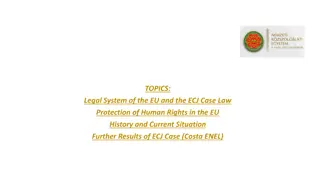Understanding Human Rights: Intersection with International Law
Exploring the concept of human rights, this course delves into the diverse aspects of civil, political, social, economic rights, and their intersection with international law. Covering historical perspectives, philosophical roots, and contemporary implications, it emphasizes the universality, indivisibility, and interdependence of human rights.
Download Presentation

Please find below an Image/Link to download the presentation.
The content on the website is provided AS IS for your information and personal use only. It may not be sold, licensed, or shared on other websites without obtaining consent from the author. Download presentation by click this link. If you encounter any issues during the download, it is possible that the publisher has removed the file from their server.
E N D
Presentation Transcript
Tishk International University FASE, IRD Department Political Thought II Code: IRD 204 UNIT VIII: HUMAN RIGHTS COURSE EDUCATOR: DR. NEVILLE D CUNHA Associated Professor
IRD 204: PT II/ Human Rights Human rights are the basic rights and freedoms to which all humans are entitled." Examples of rights and freedoms which are often thought of as human rights include civil and political rights, such as the right to life, liberty, and property, freedom of expression, pursuit of happiness and equality before the law; and social, cultural and economic rights, including the right to participate in science and culture, the right to work, and the right to education.
IRD 204: PT II/ Human Rights In this chapter we will focus on understanding how, why and with what theoretical, political, and practical implications, the critical concerns of 21stCentury intersect with key issues of international law and human rights. 1993 UN World Conference on Human Rights held in Vienna, Austria plainly states: all human rights are universal, indivisible and interdependent and interrelated.
IRD 204: PT II/ Human Rights Philosophers such as Thomas Paine, John Stuart Mill and Hegel expanded on the theme of universality during the 18th and 19th centuries. In 1831 William Lloyd Garrison wrote in a newspaper called The Liberator that he was trying to enlist his readers in "the great cause of human rights" so the term human rights probably came into use sometime between Paine's The Rights of Man and Garrison's publication. In 1849 a contemporary, Henry David Thoreau, wrote about human rights in his treatise On the Duty of Civil Disobedience which was later influential on human rights and civil rights thinkers. United States Supreme Court Justice David Davis, in his 1867 opinion for Ex Parte Milligan, wrote "By the protection of the law, human rights are secured; withdraw that protection and they are at the mercy of wicked rulers or the clamor of an excited people
IRD 204: PT II/ Human Rights Three Generations of Rights: First Generation: Civil and Political Rights. Second Generation: Social, Economic and Cultural Rights Third Generation: Solidarity or Collective Rights To be sure, the rights of free expression, free association, and free exercise quintessential examples of the civil and political rights of the first generation are at best meaningless without the health, education and social security rights all of the second generation. Similarly, these health, education, and social security rights are illusory without the peace or environment to facilitate them. Moreover, trade union rights and property rights can be viewed as either (or both) civil and political or social and economic rights.
IRD 204: PT II/ Human Rights The Framework: International Human Rights Law International human rights are those rights vital to an individual existence; they are fundamental, inviolable, interdependent, indivisible, and inalienable rights. The foundation for human rights is the individual s status qua individual within the international community and the dignity and justice owed to persons based upon that status. Consequently, there can be no challenge to the universal acceptance that for e.g. genocide, race, discrimination, and terrorism are wrong and universally condemned regardless of whether the actors are states or private persons and regardless of the victims nationality.
IRD 204: PT II/ Human Rights The Framework: International Human Rights Law In the beginning, individual human rights were not part of the international law paradigm. Rather, the concern of international affairs was left exclusively to the state. Such notions notwithstanding, early writers recognized the importance of individuals to the Law of Nations because individuals are personal basis of every State and consequently, international law must provide certain rules regarding individuals. Individuals, however, were deemed to be objects, and not subjects, of the Law of Nations.
IRD 204: PT II/ Human Rights Human Rights: Individualistic The modern view of human rights, placing the individual at the center, emerged in 1945 in the wake of the Nuremberg and Tokyo trails and the vivid awareness of the Nazi human rights atrocities. Nuremberg clearly established that rules of international law applied to individuals. Nuremberg Tribunal stated: Crimes against international law are committed by men, not by abstract entities and only by punishing individuals who commit such crimes can the provisions of international law be enforced.
IRD 204: PT II/ Human Rights United Nations Charter 1945 With the signing of the UN Charter in 1945, international law structurally protected individuals qua individuals against all forms of injustice regardless of whether the abuse or injustice was committed by a foreign sovereign or the individuals' own state of nationality. As such, these rights are permanent and universal and are ingrained as a purpose of the UN Charter to promote and encourage respect for human rights and fundamental freedoms
IRD 204: PT II/ Human Rights United Nations Charter 1945: Criticism Significantly, the universality of rights is founded in Western philosophy and thus open to attack for lacking Southern, Eastern or African linkages. More recently, post-Cold War discord and its attendants results of increased nationalism, ethnic strife, civil wars, and human rights abuses for which the community of nations was not prepared have presented a grave challenge to the continued development of human rights law.
IRD 204: PT II/ Human Rights Universal Declaration of Human Rights 1948 It is a comprehensive document that addresses not only civil and political rights, but also economic, social and cultural rights a testament to the indivisibility and interdependence of rights. Although there is ongoing debate on the legal status of the Universal Declaration, many scholars consider to be legally binding as a general principle of international law while others consider it to have the status of jus cogens a peremptory norm.
IRD 204: PT II/ Human Rights Universal Declaration of Human Rights 1948 Included in the UD s protections of civil and political rights are the prohibition of slavery, inhuman treatment, arbitrary arrest, and arbitrary interference with privacy, as well as a broad, nondiscrimination provision that mandates equality on the grounds of race, color, sex, language, religion, political or other opinion, national or social origin, property, birth, or other status.
IRD 204: PT II/ Human Rights Universal Declaration of Human Rights 1948 In addition, the UD provides for rights to a fair trial, to freedom of movement and residence, to political asylum, to have and change nationality, to marry, to own property, to freedom of belief and worship, to freedom of opinion and expression, to freedom of peaceful assembly and association, to free elections, and to equal opportunities for access to public positions.
IRD 204: PT II/ Human Rights Universal Declaration of Human Rights 1948 As to social, economic, and cultural rights, the UD recognizes the rights to social security, full employment, fair working conditions, an adequate standard of living, education, and participation in the cultural life of the community.
IRD 204: PT II/ Human Rights Human Rights: Summary The notion of the individual in the global context is a concept broader than citizenship with protections of individuals based on their personhood. Significantly, all states, not just the state of nationality, owe all peoples, not just their citizens, these international protections.
IRD 204: PT II/ Human Rights Human Rights: Summary Finally, the lesson from Nuremberg and its progeny is that state sovereignty cedes to human rights protections. Consequently, international human rights norms set the proper baseline scope and limits of state intervention in civil society as well as the threshold observance of such rights in any regional or international agreement.
IRD 204: PT II/ Human Rights Human Rights: Summary Human rights can serve to urge, promote, and insist upon a local to universal theoretical construct that eschews the single-trait, myopic approach of our system of laws in favor of a holistic one that promotes the indivisibility and interdependence of our identities.
IRD 204: PT II/ Human Rights Human Rights: Summary Rather than focus on our differences, let our multiple identities be at the center of the creation of a cohesive human rights theory that insists upon our protections notwithstanding our differences.























